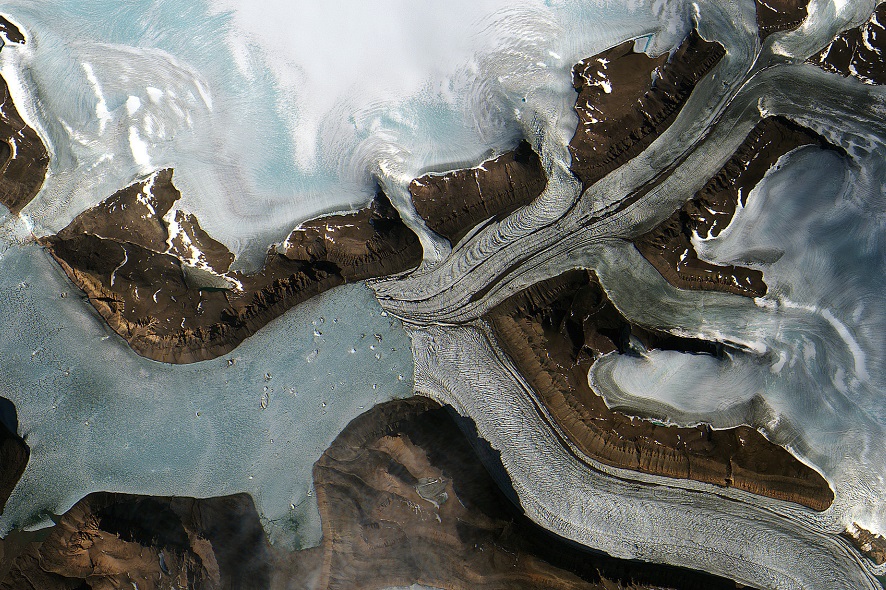There’s no telling exactly how many satellites are orbiting Earth, according to Othmar Coser of the ÖWF–Austrian Space Forum. What he’s absolutely certain of, though, is that many of them gather and deliver data that are essential for life on our planet and its environmental impact.
Details will be provided by Othmar Coser, an expert in the field of Earth observation, at the next Deep Space LIVE event in the Ars Electronica Center on December 14, 2017 at 7 PM. His talk entitled “Eye in the Sky” will be accompanied by impressive images of Planet Earth taken from space. He’ll discuss how scientists are using data gathered by satellites, and tell what happens to the technology once it stops transmitting information. We recently sat down with Othmar Coser to learn more.

Credit: Namib / Satellite: Kompsat-2, KARI/ESA
What does the Austrian Space Forum do?
Othmar Coser: The ÖWF performs research in the field of space travel, and especially travel to Mars. To do so, we’ve developed our own space suit simulator, Aouda.X, which we use to conduct analog Mars simulations. The next one is set for February 2018 in the desert in Oman. We always conduct our simulations in cooperation with research facilities, and we stage these manned missions to Mars and stays in outer space as authentically as this can possibly be done on Earth.
Why is there an organization doing research on outer space here in Austria, of all places?
Othmar Coser: This is a matter of enthusiasm. Our chairman, Gernot Grömer, has a Ph.D. in astrophysics. He founded this association about 20 years ago with a few enthusiasts who have backgrounds in engineering and law, or were involved with the European Space Agency (ESA) and the DLR–German Aerospace Center. This group is actually based on interest in the subject of space travel.
I’m assistant CFO and do a lot of work with Earth observation. On one hand, this has to do with space travel and satellite technology; on the other hand, though, this is an environmental issue. Space technology is part of the effort to understand events happening here on Earth, or at least their impact. How long can we still maintain our planet on this level? When will it reach the tipping point?
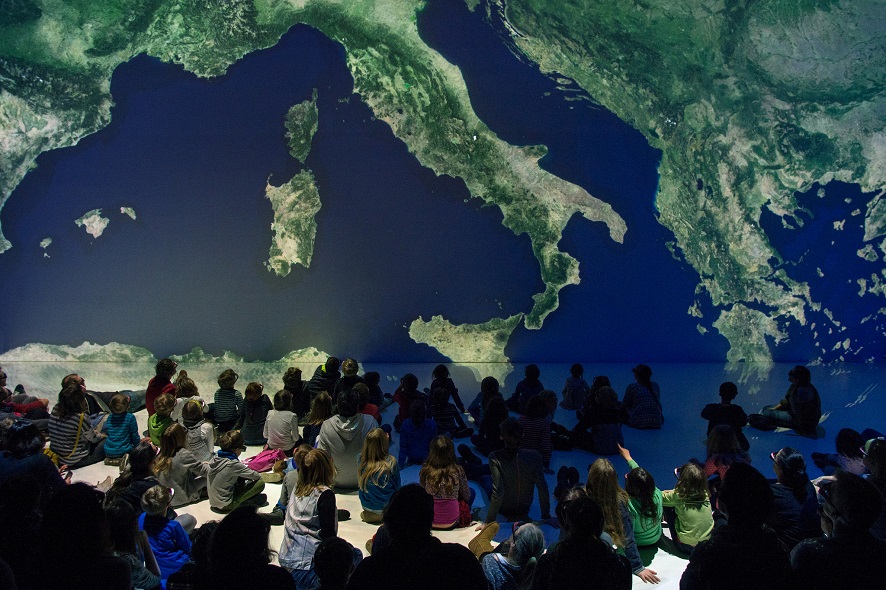
Credit: Christopher Sonnleitner
Your talk in Deep Space has to do with precisely this subject, Earth observation. How many satellites are actually flying around up there?
Othmar Coser: The exact number is unknown, since, for example, the number of military satellites is generally kept secret. Intelligence agencies know this, if anyone does. In the case of Earth observation satellites, it depends. There are 15 companies worldwide launching satellites. The ESA has 15 satellites in orbit at present.
What do these satellites measure?
Othmar Coser: They measure various environmental parameters. The first satellites launched into space were geostationary weather satellites—for instance, Meteosat in the ‘70s. We’re now in the fifth generation. There are also satellites in polar orbit—for example, to measure impurities in the air and especially atmospheric pollution, nitrogen oxide, ultraviolet exposure, CO2, temperature, wind currents, etc. Everything needed to create a global climate model. On one hand, this is necessary to forecast the weather, which, of course, has to be as precise as possible; on the other hand, we want to be able to work with these data to predict the future, so to speak, to peer into the crystal ball. What trends are emerging? How is the climate developing for coming generations?
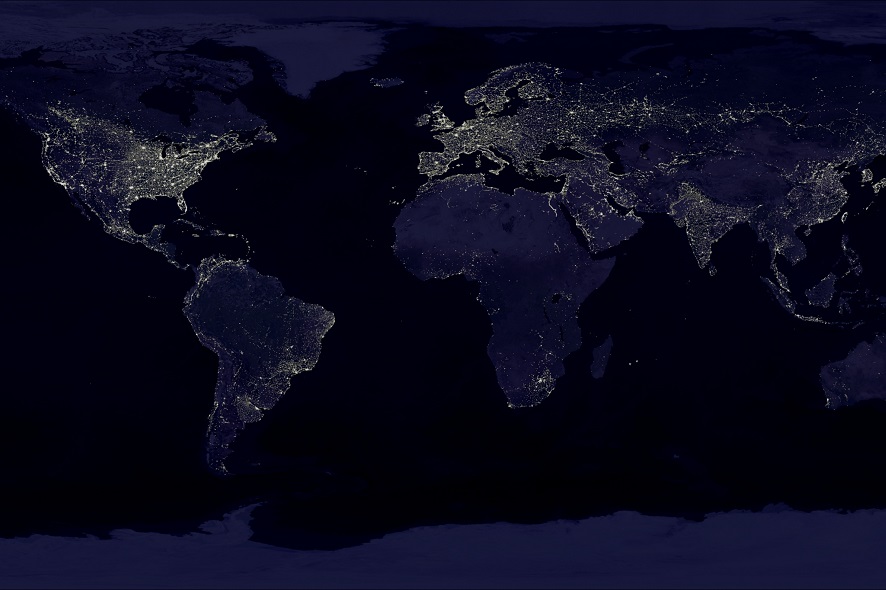
Credit: Craig Mayhew and Robert Simmon, NASA GSFC
What timeframe are we talking about here?
Othmar Coser: Measurements have already been taken since the 1970s. The Apollo Program got this underway. The first men who flew to the Moon suddenly recognized what a precious jewel we live on. This is manifested very clearly by the many photos of our planet that were shot at the time. For example, astronaut Gene Cernan said: “We went to explore the Moon and in fact discovered the Earth.” One observed one’s own habitat. As far as we know at present, the Earth is the only heavenly body we can exist on. There’s nothing else at the moment. Even if lots of extraterrestrial planets are being discovered year after year, we have to stay grounded in reality here. We can indeed identify these planets with signals we transmit and then photograph them, but the tremendous distances to them make them impossible to reach. This has to be stated clearly!
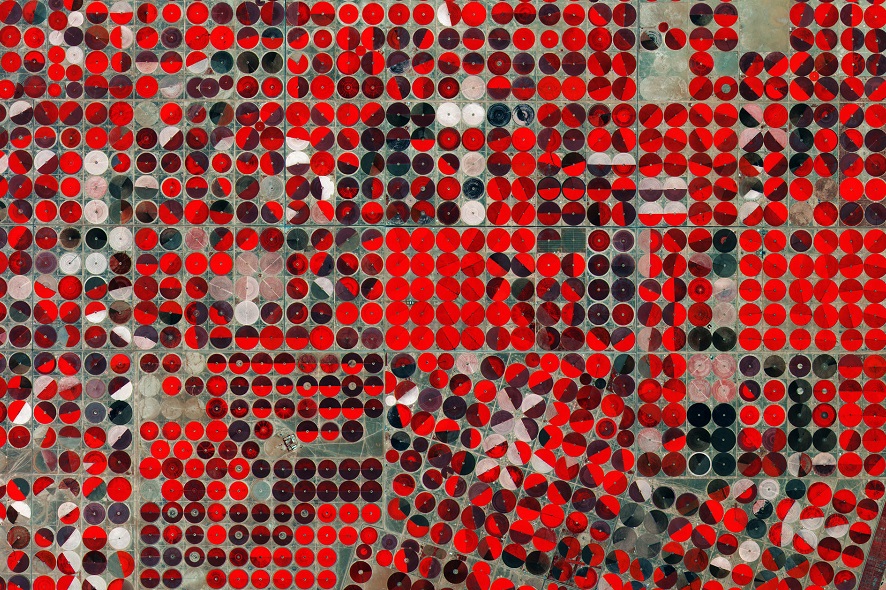
Credit: fields in desert, Tubarjal / Satellite: Sentinel-2, Copernicus Sentinel data (2015)
That means that we now have data from the last 50 years …
Othmar Coser: …and we’re continually adding to them. As technology progresses, the measuring devices get increasingly precise. Plus, new satellites are developed to gather new kinds of data. These projects run for up to 10 years—development and construction are only the initial phases; usually, they’re planned for a five-year useful life in orbit. Envisat, currently the largest environmental satellite, was launched by the ESA in 2002. This was originally planned to be a five-year mission—that is, until 2007—but Envisat remained in service until 2012. Radio contact was lost on Easter 2012.
What happens to satellites that have ceased transmitting?
Othmar Coser: They remain aloft. Most of them are orbiting at an altitude at which gravitation is very weak or has no effect. That means they’re less subject to attraction than, for example, the International Space Station, which orbits 400 kilometers lower, where gravitation is stronger. That’s why the ISS has to be repeatedly raised to a higher orbit. Satellites, on the other hand, remain aloft even when they don’t function anymore. This is the typical origin of space junk.
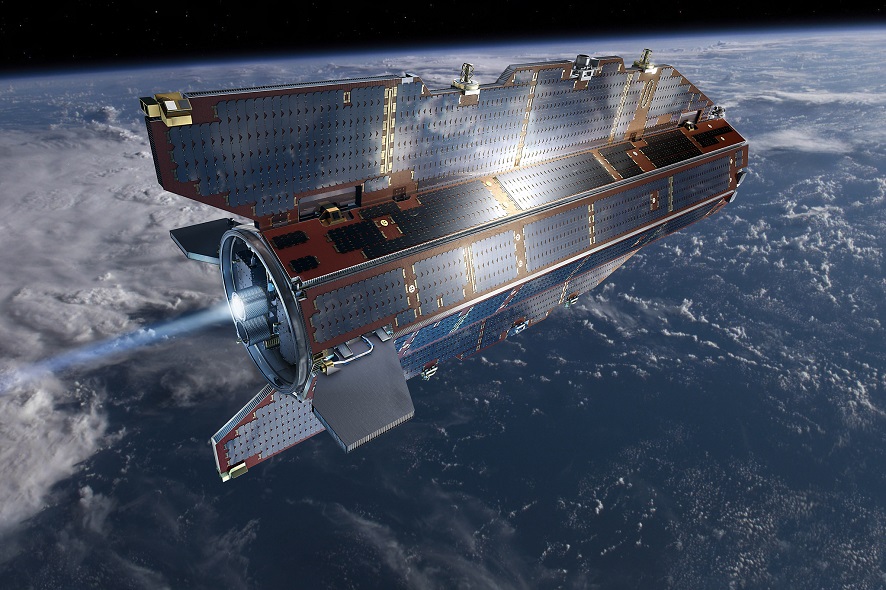
GOCE. Credit: ESA–AOES-Medialab
What about the ones that are brought back to Earth?
Othmar Coser: These satellites mostly burn up upon reentering the Earth’s atmosphere. One of the most recent ones was GOCE, an ESA satellite designed to measure gravitation. Its sole mission was global measurement of Earth’s gravitation, which is why it flew at such a low orbit—an altitude of only 240 kilometers. GOCE was the Ferrari of satellites, but to make it go so fast, it needed its own propulsion system because, at that altitude, friction and gravity would otherwise have slowed it down. It orbited for three years until its fuel was exhausted. Then it was recalled, although that’s not quite as simple as it sounds. Actually, a lot of planning went into it. Due to conditions prevailing in the area of its orbit, a slow descent begins as soon as propulsion ceases and the Earth’s gravity gets the upper hand. Then ESA technicians track the reentry, whereby the satellite breaks up due to the forces acting upon it. Many of its components burn up; most of the rest plunges into the ocean, far out to sea. No one has yet been hit on the head by a piece of a satellite.
Have these observations revealed trends in how the environment is changing?
Othmar Coser: Yes. Especially when you analyze images of a particular area taken several years—or even several months—apart, you can see very clearly how cities or landscapes change due to human intervention. The classic example of this is the worst environmental catastrophe ever produced by a manmade incursion—the Aral Sea on what is now the Kazakhstan-Uzbekistan border. When I was in school, the Aral Sea was the world’s fourth largest lake. There’s hardly anything left of it now.
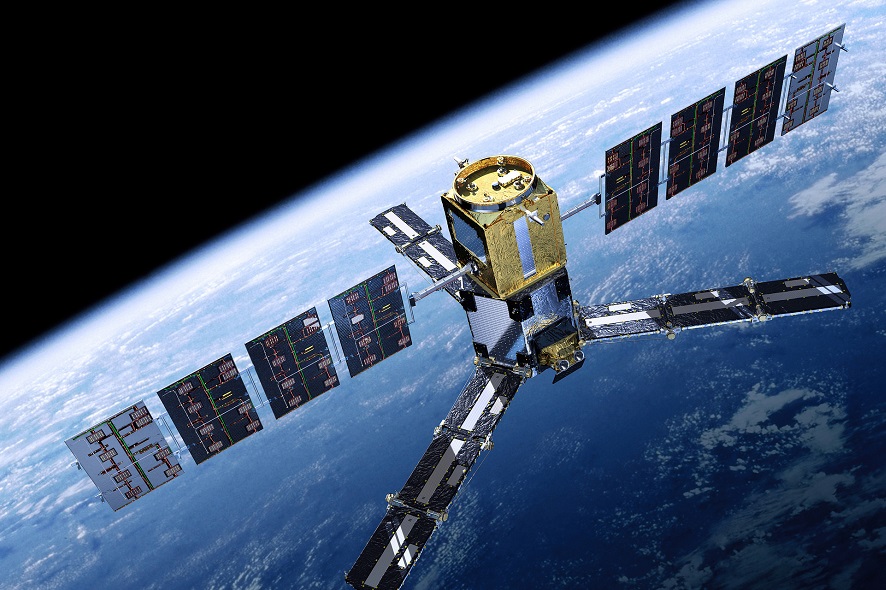
Credit: ESA/AOES Medialab
On the other hand, have there also been recognizable changes for the better?
Othmar Coser: To a much lesser extent, although this too depends on how you look at it and what you consider to be a positive change? The fact is that you see how the environment is changing to the detriment of human life. Take the case of the Aral Sea—that was a fertile region in the 1950s and ‘60s. Now it’s a desert. The climate has changed, and people’s life expectancy has fallen precipitously. There’ve been no benefits to speak of.
In other words, massive environmental impacts are being observed. But aren’t these satellites themselves stresses on the environment?
Othmar Coser: That’s a philosophical way of looking at it. Keep in mind that environmental protection isn’t done for its own sake, at least not in Austria. Environmental protection is meant to sustain the lives of human beings and our planet’s fauna. No country on Earth engages in environmental protection solely to ensure the continued existence of lush green meadows. So why shouldn’t a satellite remain in orbit? This is a philosophical question, and every person has a different approach to it. But it sure does seem weird that there’s so much junk flying around up there. On the other hand—what effect does it have on us?

Credit: ESA
But what does it do to the entire system?
Othmar Coser: That we’ll never know. The fact is that that environment can’t be made to accommodate life as we know it. There, everything is dead, according to our conceptions.
How important are these satellites for our life here on Earth?
Othmar Coser: They’re important in two ways. With respect to the technological aspect of space travel, satellites are essential because much of this technology flows into everyday life. Consider your cell phone, for example—I’m not sure that this technology could have been developed to this extent if humankind had not ventured out into space. And then there are the developments in vehicle construction and their safety systems. Or what about household appliances like the microwave? Satellite technology leads to social and scientific progress, fosters the propagation of knowledge and broadens our perspectives, produces economic growth and makes daily life more convenient.
With respect to environmental relevance, the hope is that satellites will enable us not only to administer the data but also to interpret them. The ultimate aim is to be able to warn people ever faster—of an impending natural catastrophe, for instance—and to thereby save lives. Needless to say, these disasters can’t be prevented but they can be detected, and hopefully in a timely manner. This is also a matter of finally recognizing that the pollutants we emit into the atmosphere are harmful to us personally. It’s a delusion to believe that what gets discharged into the air doesn’t come back to Earth somewhere.

Othmar Coser was born in 1958 in Innsbruck. He is assistant chief financial officer of the ÖWF–Austrian Space Forum and coordinates the organization’s talks about Earth observation. He was a repro photographer until 1978; since then, he has worked in law enforcement in various capacities—since 1994 as head of the Environmental Crimes Unit at the Province of Upper Austria’s Bureau of Investigation. He thus has a thorough knowledge of Austrian environmental laws and regulations. Since March 2010, he has organized the talks given in conjunction with the Eye in the Sky Initiative of the ÖWF and the State of Upper Austria.
At the next Deep Space LIVE on December 14th at 7 PM, Othmar Coser will talk about Earth observation from space and screen impressive satellite images. More information about “Eye in the Sky” is available here.
To learn more about Ars Electronica, follow us on Facebook, Twitter, Instagram et al., subscribe to our newsletter, and check us out online at https://ars.electronica.art/news/en/.
